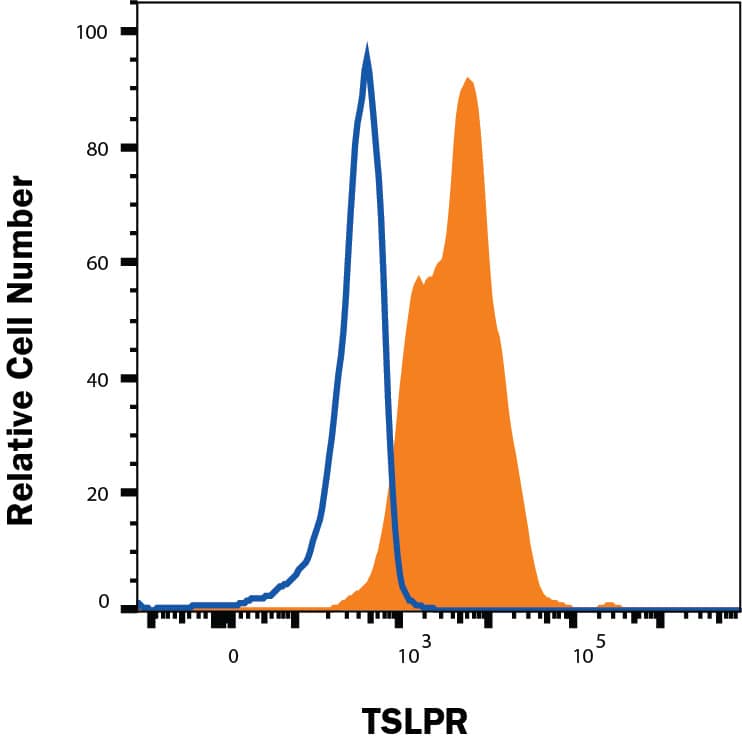Human TSLPR Antibody
R&D Systems, part of Bio-Techne | Catalog # MAB981


Key Product Details
Species Reactivity
Validated:
Cited:
Applications
Validated:
Cited:
Label
Antibody Source
Product Specifications
Immunogen
Gly25-Lys231
Accession # Q9HC73
Specificity
Clonality
Host
Isotype
Scientific Data Images for Human TSLPR Antibody
Detection of TSLPR in HEK cells by Flow Cytometry.
HEK cells transfected with hTSLPR (filled histogram) vs Irrelevant HEK transfectant cells (open histogram) were stained with Mouse Anti-Human TSLPR Monoclonal Antibody (Catalog # MAB981), followed by Phycoerythrin-conjugated Anti-Mouse IgG Secondary Antibody (Catalog # F0102B). View our protocol for Staining Membrane-associated Proteins.Applications for Human TSLPR Antibody
CyTOF-ready
Flow Cytometry
Sample: HEK cells transfected with hTSLPR vs Irrelevant HEK transfectant cells
Western Blot
Sample: Recombinant Human TSLPR Fc Chimera (Catalog # 981-TR)
Formulation, Preparation, and Storage
Purification
Reconstitution
Formulation
Shipping
Stability & Storage
- 12 months from date of receipt, -20 to -70 °C as supplied.
- 1 month, 2 to 8 °C under sterile conditions after reconstitution.
- 6 months, -20 to -70 °C under sterile conditions after reconstitution.
Background: TSLPR
TSLP R, also named Delta (1) and CRLM-2 (2) (cytokine receptor-like module-2), was originally cloned as a novel type 1 cytokine receptor with similarity to the common gamma chain. It was subsequently identified to be a subunit of the cellular receptor for the IL-7-like cytokine TSLP and termed TSLP R (3). The human TSLP R cDNA encodes a 371 amino acid (aa) residue type 1 membrane protein with a 22 aa residue signal peptide, a 210 aa residue extracellular domain, a 20 aa residue transmembrane domain, and a 119 aa residue cytoplasmic domain (4, 5). The extracellular region contains two fibronectin type III-like domains and a WSXWS-like motif. The cytoplasmic domain contains a membrane-proximal box 1 motif that is known to be important for association with JAKs (4). Human TSLP R displays 39% identity to mouse TSLP R and 24% identity to the common gamma receptor (4). An alternatively spliced mRNA variant encoding a soluble TSLP R has also been reported in mouse (2). TSLP R expression is ubiquitous in the immune and hematopoietic cells, but is up-regulated in Th2-skewed cells. Cells expressing TSLP R alone bind TSLP with low affinity. Co-expression of TSLP R and IL-7 R alpha is required for high-affinity TSLP binding and signal transduction (3‑6). The TSLP R and IL-7 R alpha are co‑expressed primarily on monocytes and dendritic cells and at lower levels in lymphoid cells. TSLP has been shown to induce the release of T cell-attracting chemokines from monocytes and enhance the maturation of CD11c+ dendritic cells (5).
References
- Fujio, K. et al. (2000) Blood 95:2204.
- Hiroyama, T. et al. (2000) Biochem. Biophys. Res. Commun. 272:224.
- Park, L.S. et al. (2000) J. Exp. Med. 192:659.
- Tonozuka, Y. et al. (2001) Cytogenet. Cell Genet. 93:23.
- Reche, P.A. et al. (2001) J. Immunol. 167:336.
- Pandey, A. et al. (2000) Nat. Immunol. 1:59.
Long Name
Alternate Names
Gene Symbol
UniProt
Additional TSLPR Products
Product Documents for Human TSLPR Antibody
Product Specific Notices for Human TSLPR Antibody
For research use only